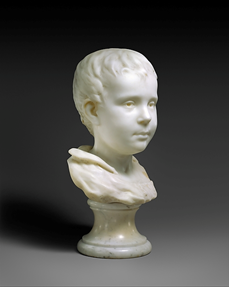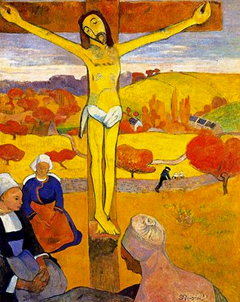Paul Gauguin
(French, 1848-1903)
Chronology
-
Event
-
Gauguin was born in Paris. His father was a journalist and his mother was the daughter of a socialist leader. His great-grandfather was nobility.
-
The family moved to Peru, but Gauguin’s father died on the voyage. Gauguin, his mother and his sister lived with his uncle’s family in Lima for four years.
-
Gauguin’s family returned to France and lived in Orléans with his grandmother. He attended Catholic boarding school and learned French for the first time.
-
At 17 years old, Gauguin joined the merchant marines to fulfill his mandatory military service.
-
Gauguin joined the French navy. His mother died in the same year.
-
Gauguin returned to Paris, where his mother’s boyfriend helped him to secure a job with the French stock market.
-
Gauguin met and married a Danish woman, Mette-Sophie Gad. He began painting in his free time. He befriended Camille Pissaro, who introduced him to other artists.
-
Émilie Gauguin was born.
-
Aline Gauguin was born.
-
Clovis Gauguin was born. The artist exhibited a sculpture of Émile at the encouragement of Pissaro.
-
Jean Réne Gauguin was born. The artist showed his first paintings at an Impressionist exhibit.
-
Paul Rollon Gauguin was born.
-
Gauguin moved his family to Copenhagen to pursue a business opportunity, which eventually fell through.
-
Gauguin had been exploring the possibility of a career in art since the stock market crash of 1882. In 1885, he returned to France alone to pursue this idea full-time. His relationship with his family disintegrated over time. He became a follower of Paul Cezanne and purchased several of his paintings.
-
Gauguin visits Panama and Martinique with his friend and fellow artist, Charles Leval. He lived in a hut and became ill with dysentery and marsh fever. The exact number of paintings that he created during this time is unknown.
-
Gauguin spent nine weeks painting with Vincent Van Gogh in Arles. The two artists had a falling out. Van Gogh threatened Gauguin with a razor blade and infamously cut off a piece of his own ear. Gauguin painted a famous piece titled Vision After the Sermon in Pont-Aven, Brittany in this year, as well. We see him begin to experiment with harsh yellows and reds and the technique of Cloisonnism.


-
Event
-
Gauguin painted The Yellow Christ and organized a show at a café owned by a Mr. Volpini on the grounds of the 1889 Exposition Universelle. Among the works he exhibited was a set of ten yellow zincographs – the artist’s first experimentation with printmaking.
-
Driven by a desire to escape conventional civilization, Gauguin moved to Tahiti for the first time. This was a very artistically prolific time for him and he also published a book about his experiences, titled Noa Noa. He had several mistresses and several children by those mistresses, but he never remarried. Germaine Gauguin was born in 1891.
-
Gauguin returned to France and began working on Mahana No Atua (Day of the God), which was finished the following year.
-
The artist went back to Tahiti and only returned to France once more before his death, to paint again in Pont-Aven.
-
Gauguin fathered a daughter, but she died just a few days after her birth.
-
Gauguin moved to Punaauia and painted his masterpiece, Where do we come from? What are we? Where are we going? His daughter Aline died of pneumonia.
-
Émile Marae a Tai Gauguin was born.
-
Gauguin’s son, Clovis, died of a blood infection.
-
The artist sailed for Hiva Oa, always searching for a lost paradise.
-
Another daughter was born. There is some speculation that she may have been Belgian artist Germaine Chardon.
-
Gauguin was charged with libeling the French governor of Tahiti. He was given a fine and sentenced to three months in prison. However, he overdosed on morphine before the sentence could be carried out. Many scholars believe that the artist suffered from syphilis.



